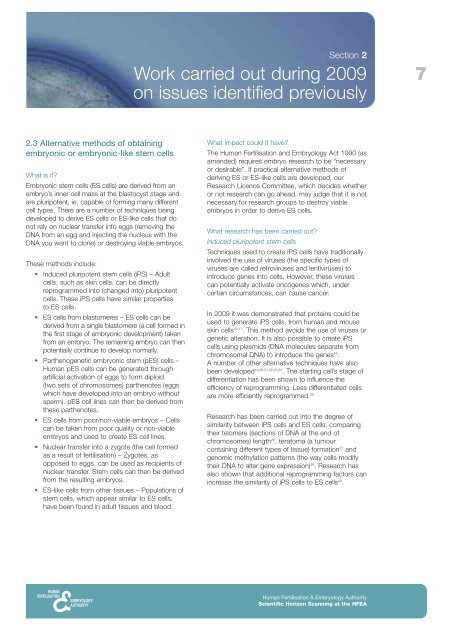Annual report 2009/10 - Human Fertilisation and Embryology Authority
Annual report 2009/10 - Human Fertilisation and Embryology Authority
Annual report 2009/10 - Human Fertilisation and Embryology Authority
Create successful ePaper yourself
Turn your PDF publications into a flip-book with our unique Google optimized e-Paper software.
Section 2<br />
Work carried out during <strong>2009</strong><br />
on issues identified previously<br />
7<br />
2.3 Alternative methods of obtaining<br />
embryonic or embryonic-like stem cells<br />
What is it?<br />
Embryonic stem cells (ES cells) are derived from an<br />
embryo’s inner cell mass at the blastocyst stage <strong>and</strong><br />
are pluripotent, ie, capable of forming many different<br />
cell types. There are a number of techniques being<br />
developed to derive ES cells or ES-like cells that do<br />
not rely on nuclear transfer into eggs (removing the<br />
DNA from an egg <strong>and</strong> injecting the nucleus with the<br />
DNA you want to clone) or destroying viable embryos.<br />
These methods include:<br />
• Induced pluripotent stem cells (iPS) – Adult<br />
cells, such as skin cells, can be directly<br />
reprogrammed into (changed into) pluripotent<br />
cells. These iPS cells have similar properties<br />
to ES cells.<br />
• ES cells from blastomeres – ES cells can be<br />
derived from a single blastomere (a cell formed in<br />
the first stage of embryonic development) taken<br />
from an embryo. The remaining embryo can then<br />
potentially continue to develop normally.<br />
• Parthenogenetic embryonic stem (pES) cells –<br />
<strong>Human</strong> pES cells can be generated through<br />
artificial activation of eggs to form diploid<br />
(two sets of chromosomes) parthenotes (eggs<br />
which have developed into an embryo without<br />
sperm). pES cell lines can then be derived from<br />
these parthenotes.<br />
• ES cells from poor/non-viable embryos – Cells<br />
can be taken from poor quality or non-viable<br />
embryos <strong>and</strong> used to create ES cell lines.<br />
• Nuclear transfer into a zygote (the cell formed<br />
as a result of fertilisation) – Zygotes, as<br />
opposed to eggs, can be used as recipients of<br />
nuclear transfer. Stem cells can then be derived<br />
from the resulting embryos.<br />
• ES-like cells from other tissues – Populations of<br />
stem cells, which appear similar to ES cells,<br />
have been found in adult tissues <strong>and</strong> blood.<br />
What impact could it have?<br />
The <strong>Human</strong> <strong>Fertilisation</strong> <strong>and</strong> <strong>Embryology</strong> Act 1990 (as<br />
amended) requires embryo research to be “necessary<br />
or desirable”. If practical alternative methods of<br />
deriving ES or ES-like cells are developed, our<br />
Research Licence Committee, which decides whether<br />
or not research can go ahead, may judge that it is not<br />
necessary for research groups to destroy viable<br />
embryos in order to derive ES cells.<br />
What research has been carried out?<br />
Induced pluripotent stem cells<br />
Techniques used to create iPS cells have traditionally<br />
involved the use of viruses (the specific types of<br />
viruses are called retroviruses <strong>and</strong> lentiviruses) to<br />
introduce genes into cells. However, these viruses<br />
can potentially activate oncogenes which, under<br />
certain circumstances, can cause cancer.<br />
In <strong>2009</strong> it was demonstrated that proteins could be<br />
used to generate iPS cells, from human <strong>and</strong> mouse<br />
skin cells 16,17 . This method avoids the use of viruses or<br />
genetic alteration. It is also possible to create iPS<br />
cells using plasmids (DNA molecules separate from<br />
chromosomal DNA) to introduce the genes 18 .<br />
A number of other alternative techniques have also<br />
been developed 19,20,21,22,23,24 . The starting cell’s stage of<br />
differentiation has been shown to influence the<br />
efficiency of reprogramming. Less differentiated cells<br />
are more efficiently reprogrammed. 25<br />
Research has been carried out into the degree of<br />
similarity between iPS cells <strong>and</strong> ES cells, comparing<br />
their telomere (sections of DNA at the end of<br />
chromosomes) length 26 , teratoma (a tumour<br />
containing different types of tissue) formation 27 <strong>and</strong><br />
genomic methylation patterns (the way cells modify<br />
their DNA to alter gene expression) 28 . Research has<br />
also shown that additional reprogramming factors can<br />
increase the similarity of iPS cells to ES cells 29 .<br />
<strong>Human</strong> <strong>Fertilisation</strong> & <strong>Embryology</strong> <strong>Authority</strong><br />
Scientific Horizon Scanning at the HFEA

















